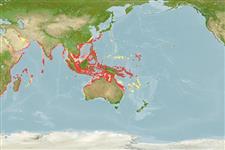Common names from other countries
>
Eupercaria/misc (Various families in series Eupercaria) >
Gerreidae (Mojarras)
Etymology: Gerres: Latin, gerres = a kind of anchovies; cited by Plinius.
More on author: Cuvier.
Environment: milieu / climate zone / depth range / distribution range
экология
морской; пресноводный; солоноватоводный демерсальный; амфидромный (Ref. 51243); пределы глубины 1 - 50 m (Ref. 4372). Tropical; 26°C - 29°C (Ref. 4959); 32°N - 35°S, 25°E - 171°E
Indo-West Pacific: East Africa and Madagascar to Japan and Australia; New Caledonia (Ref. 26587) and Vanuatu (Ref. 13300). Enters rivers and lakes in Madagascar and the east coast of Africa. Not in the Middle East (Ref. 103159).
Length at first maturity / Size / Вес / Возраст
Maturity: Lm 19.0 range ? - ? cm
Max length : 39.0 cm TL самец/пол неопределен; (Ref. 116875); common length : 15.0 cm SL самец/пол неопределен; (Ref. 4967)
колючие лучи спинного плавника (общее число) : 9; членистые (мягкие) лучи спинного плавника (общее число) : 10 - 11; колючие лучи анального плавника: 2 - 3; членистые (мягкие) лучи анального плавника: 7 - 8.
Adults are coastal inhabitants found on soft bottoms (Ref. 44894), over sandy substrate (Ref. 12693). Juveniles are found in brackish mangrove estuaries, sometimes enter fresh water (Ref. 2847, 44894), lakes (Ref. 4323), tidal creeks (Ref. 44894) and lower freshwater reaches of rivers (Ref. 12915). Feed on small crustaceans, polychaetes and forams on sand or muddy-sand bottoms (Ref. 12915), worms and insect larvae (Ref. 12693). Length at first reproduction was reported to be around 12 cm SL, for a population in a South African estuary (D. Woodland, pers.comm. 07/13). Salted or made into fish sauce.
Juveniles enter estuaries and mangrove areas at 1 cm SL and stay until they reach maturity, at which stage they move out to sea (Ref. 36558).
Woodland, D.J., 1984. Gerreidae. In W. Fischer and G. Bianchi (eds.) FAO species identification sheets for fishery purposes. Western Indian Ocean fishing area 51. Vol. 2. [pag. var.]. FAO, Rome. (Ref. 3409)
Статус Красного Списка МСОП (Ref. 130435)
CITES (Ref. 128078)
Not Evaluated
Угроза для людей
Harmless
Использование человеком
рыболовство: не имеет хозяйственного значения
дополнительная информация
инструменты
Специальные отчеты
Скачать в формате XML
ресурсы в Интернет
Estimates based on models
Preferred temperature (Ref.
115969): 24.8 - 29.1, mean 28.2 (based on 1220 cells).
Phylogenetic diversity index (Ref.
82804): PD
50 = 0.5000 [Uniqueness, from 0.5 = low to 2.0 = high].
Bayesian length-weight: a=0.01230 (0.01004 - 0.01507), b=3.05 (3.01 - 3.09), in cm Total Length, based on LWR estimates for this species (Ref.
93245).
Trophic level (Ref.
69278): 3.3 ±0.2 se; based on diet studies.
устойчивость к внешним воздействиям (Ref.
120179): высокий, минимальное время удвоения популяции до 15 месяцев (K=0.7).
Fishing Vulnerability (Ref.
59153): Low to moderate vulnerability (32 of 100).
